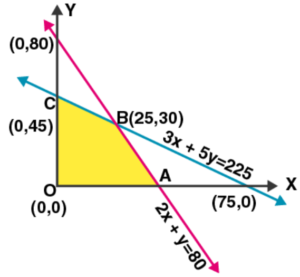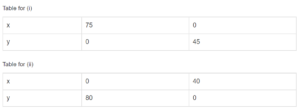Let’s take x an y to be the number of models of bike produced by the manufacturer.

From the question we have,
Model x takes
![]()
man-hours to make per unit
Model y takes
![]()
man-hours to make per unit
Total man-hours available =
![]()
So,
![]()
….. (i)
The handling and marketing cost of model x and y are Rs
![]()
and Rs
![]()
respectively.
And, the total funds available is Rs
![]()
per week
So,
![]()
… (ii)
And,
![]()
Now, the total profit (Z) per unit of models x and y are Rs
![]()
and Rs
![]()
repectively
⇒
![]()
Hence, the required LPP is
Maximize
![]()
subject to the constraints
![]()
Now, let’s construct a constrain table for the above:

Next, on solving equation (i) and (ii) we get
![]()
After plotting all the constraint equations, we observe that the feasible region is OABC, whose corner points are
![]()
On evaluating the value of Z, we get

Therefore, from the above table it’s seen that the maximum profit is Rs
![]()
.
The maximum profit can be achieved by producing
![]()
bikes of model x and
![]()
bikes of model Y or by producing
![]()
bikes of model x.
